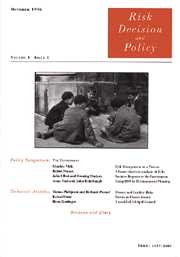Article contents
Impact of BSE on attitudes to GM food
Published online by Cambridge University Press: 24 August 2001
Abstract
The aim of this research is to determine whether people in the UK associate genetically modified food (GM food) with the ‘mad cow’ disease (or BSE) issue, and explain any such association in terms of analogical reasoning. Further, to test whether a lack of perceived ‘control over exposure’ to GM food accounts for the heightened vulnerability it is typically associated with. Two consecutive questionnaires were administered in various regions of the UK. The first asked 200 participants to indicate whether they regarded GM food as a health risk, and to spontaneously identify issues similar to GM food. The second asked a further 200 to rate the similarity between GM food and BSE, Salmonella, and food irradiation, and to give personal and general risk ratings for consuming GM food, and tolerance ratings for its availability and availability if ‘always clearly labelled’. The results indicate GM food is overwhelmingly identified as a health risk, and that BSE is widely held to be analogous with GM food. However, BSE was rated as less similar to GM food than food irradiation. The widespread identification of BSE as an analogue is explained in terms of it representing a ‘worst-case scenario’. The risk ratings are consistent with the heightened sense of vulnerability associated with GM food; the tolerance ratings are greater for the availability of GM food if ‘always clearly labelled’, indicating a perceived lack of control over exposure to GM food accounts, in part, for GM food risk perceptions. However, the results also indicate that, in terms of practical risk management, labelling may only be effective with respect to a younger age group.
- Type
- Technical Article
- Information
- Copyright
- © Cambridge University Press, 2001
- 15
- Cited by




